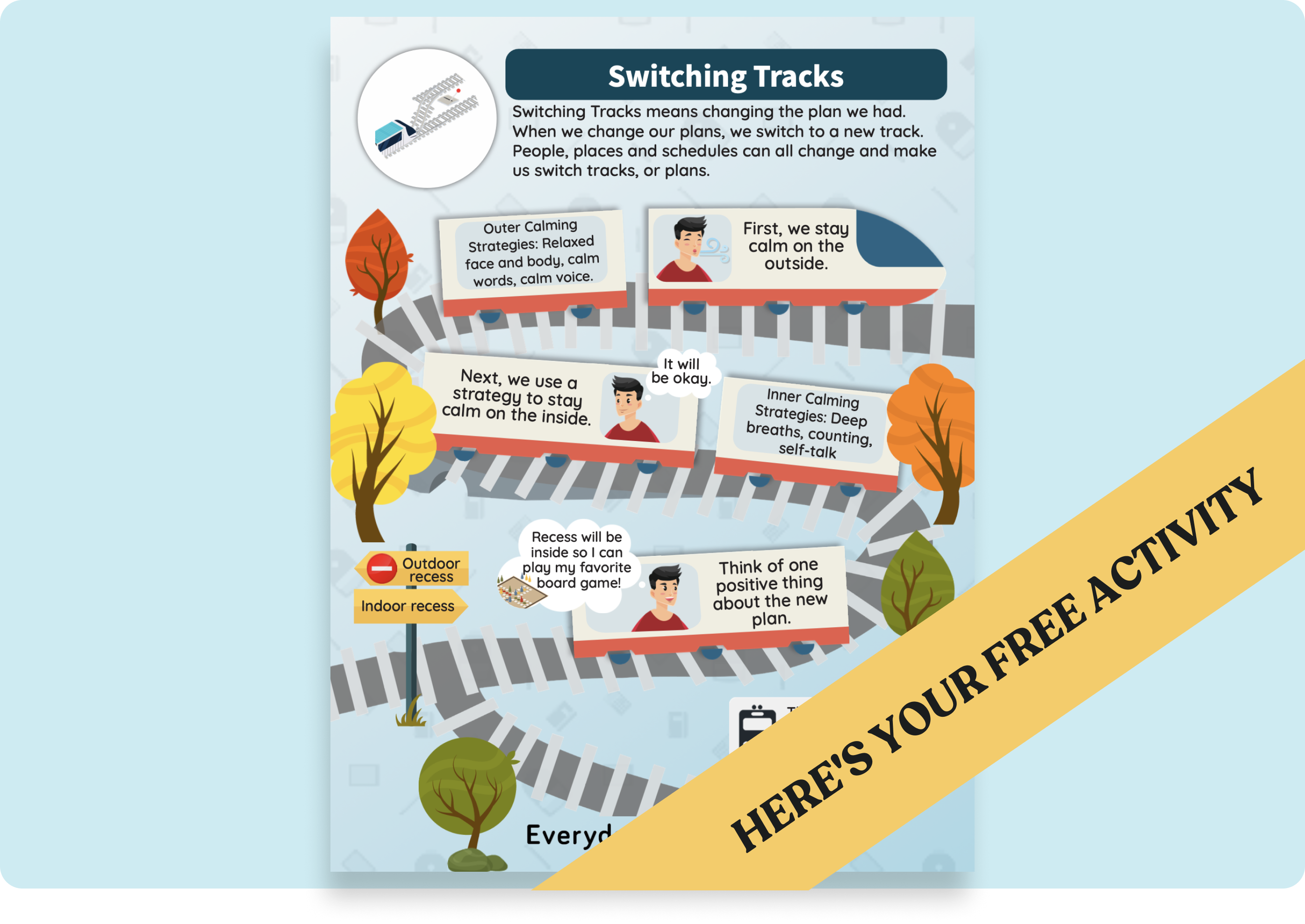Download 20+ Self-Regulation Activities for PK-12
No-prep tools to teach students how to stay calm, make thoughtful choices, and build emotional awareness.
Smooth transitions are a foundational part of a successful classroom environment, especially for young students in Pre-K and Kindergarten. Self-regulation skills, like being able to stop one activity and start another, set the stage for further growth and learning. The Switching Tracks Goal Poster provides an engaging, visual tool that helps early learners practice shifting their attention and actions from one task to another—sometimes called “switching tracks.” This article outlines how to introduce, model, and use the Switching Tracks Goal Poster in a classroom or therapy setting, and how to encourage generalization of these skills throughout the school day.
What Is Switching Tracks?
Switching tracks refers to the ability to stop doing one thing and start doing something new, mentally and behaviorally. For preschoolers and kindergarteners, this skill can mean ending art time and moving to circle time, or putting away toys to get ready for snack. Switching tracks is a component of self-regulation that requires children to control impulses, follow directions, and adapt to new routines. Young learners may struggle with these shifts, but structure and visual supports can foster smoother transitions.
The Switching Tracks Goal Poster presents a clear and concrete way for children to see and remember the steps involved in making transitions. It visualizes goal behaviors such as listening for the transition cue, stopping the current activity, and beginning the next one. By making expectations explicit, and using supportive visuals, children become more aware of what is being asked and how they can succeed.
Why Teach Switching Tracks?
Supporting children in developing switching tracks skills early on has wide-ranging benefits:
- Builds foundational self-regulation, increasing attention and flexibility
- Reduces frustration and disruptive behaviors during daily transitions
- Establishes routines that promote a positive and predictable classroom environment
- Encourages independence when moving between tasks or centers
- Prepares children for future academic and social settings where transitions are common
- Helps students feel successful and confident as they master new routines
- Enhances communication between educators, students, and families regarding expectations
When students have ways to practice and reinforce switching tracks, the classroom becomes a place where time is used efficiently, expectations are clear, and everyone can participate more comfortably.
Lesson Plan: Using Switching Tracks Goal Poster
Download 30+ Printable Social Skills Posters
Ready-to-use visuals for emotional regulation, self-advocacy, and more
A no-prep tool like the Switching Tracks Goal Poster can be smoothly woven into class or small group sessions. The following lesson structure walks through introducing, modeling, and practicing switching tracks with Pre-K and Kindergarten students.
Step 1: Introducing the Concept
Begin by gathering students in a group on the carpet or at their tables. Show the Switching Tracks Goal Poster. Use concrete language: “Switching tracks means stopping what we are doing and starting something new. Just like a train can move from one track to another.”
Point out visual cues on the poster. For example, highlight the picture of the train moving to a new track. Explain that everyone can learn to switch tracks when it is time.
Check for background knowledge. Ask, “Has anyone ever had to stop playing to do something else? How did that feel?” This helps normalize the experience of finding transitions hard sometimes.
Step 2: Introducing the Poster Steps
Talk through each step shown on the poster:
- Listen for the cue to switch tracks (such as a bell, the teacher’s voice, or a song).
- Stop what you are doing.
- Look and listen to find out what to do next.
- Move calmly and safely to the next activity.
Use the images on the poster as visual anchors during your explanation. This helps children understand what those actions might look like and what is expected.
Step 3: Modeling Switching Tracks
Model each step yourself first. For example, pretend you are coloring. Say, “I’m drawing, but I hear the clean-up song. That means it is time to switch tracks. I will put my marker down and listen for what is next.” Move according to the steps on the poster.
Invite a co-teacher or helper to model switching tracks with exaggerated gestures. For example, purposely ignore the cue, then try again and do it the right way, so the group can see the difference.
Step 4: Guided Practice
Set up a brief activity, such as stacking blocks or sorting shapes. Give the switching tracks cue, then walk students through each poster step:
- “I hear the bell! What do we do?”
- “We stop building and listen.”
- “We look at our teacher to find out what is next.”
- “Let’s move just like the train to our next spot.”
Positively reinforce students as they practice each step, using specific praise: “You stopped when you heard the cue. That was great switching tracks!”
Step 5: Visual Reminder Throughout the Day
Display the Switching Tracks Goal Poster where all students can see it—on the wall, easel, or transition station. Refer to it before each major transition. Say, “Let’s use our picture to help us switch tracks.” Gradually prompt students to refer to it on their own.
Download the poster here: Download the Switching Tracks Goal Poster.
Wrapping Up: Building Flexible Routines Together
Encouraging the ability to switch tracks empowers young learners to navigate their school environment more confidently. By making expectations predictable, visual, and engaging, the Switching Tracks Goal Poster turns transitions from a source of stress into opportunities for growth. With repeated practice, praise, and teamwork between educators and families, students lay the foundation for self-regulation that will benefit them for years to come. Remember, every transition is a chance to teach life skills—and each “switch” gets a little easier with time and support.






